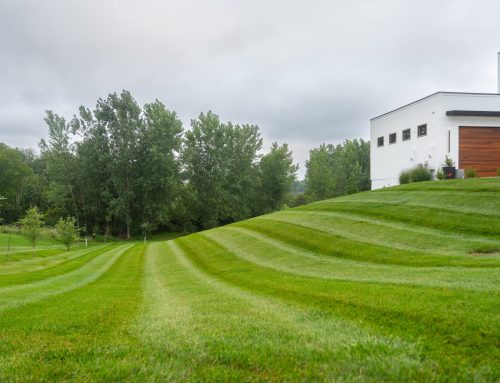Though we have had some days of warmth, winter isn’t over yet and that means there is still plenty of opportunity for ice yet this winter. What is the best way to prevent ice from building up or to melt it quickly? Ice Melt, unless you have a flame thrower like some viral videos on the internet (we are kidding, don’t use a flame thrower to melt ice), ice melt is your best and safest bet.
There are many different types of ice melt and when it comes to choosing the best one for your property, there are several things to take into consideration.
- Outside Temperature
- If you have children and/or pets
- The type of surface you are putting it down on
- The age of the surface you are putting it down on
- Your budget
Outside Temperature
The outside temperature has a lot to do with the effectiveness of your ice melt. The lowest effective temperature will be printed on the bag of ice melt. Here is a general list of the different types of ice melt and their lowest effective melting temperatures.
- Potassium Chloride: 25°F
- Urea: 25°F
- Rock Salt/Sodium Chloride: 20°F
- Magnesium Chloride: 0°F
- Calcium Chloride: -25°F
Child and Pet Safe
Magnesium Chloride is a safer choice for homes or businesses that children or pets frequent. Sodium Chloride and Calcium Chloride are highly corrosive and dangerous for children and pets to be around. Calcium chloride can burn the skin, so it is not recommended for homes or businesses with pets or children.
The Type of Surface
Before applying any ice melt it is important to know the type of surface that you are putting it down on. Calcium Chloride can lead to refreezing on wood surfaces so it isn’t recommended for decks. Certain types of ice melts such as sodium chloride can damage concrete especially if the remaining residue isn’t removed promptly after the ice has melted.
The Age of the Surface
It is important to note that if your concrete is less than three years old, you should highly consider using sand instead of any ice melt product or the ice melt might damage your concrete. Sand won’t melt the ice but it will provide additional traction on slippery surfaces and it will protect your concrete. Sand will also increase traction at any temperature, so if your ice melt only works until 0°F you can simply spread sand over the surface of the ice.
Your Budget
Depending on the amount of times you have to put down ice melt, it can get rather expensive, especially if you have a lot of space to cover. The cheapest option is sand, but it’s important to keep in mind that it isn’t going to melt your ice. It’s good to have on hand though in case the temperature drops below your ice melts lowest effective temperature. The next cheapest is sodium chloride, but that comes with it’s fair share of issues, it’s extremely corrosive or harmful to skin, children, pets, and plants. Magnesium Chloride is on the more expensive side but it is effective until 0°F and it is also safe for children and pets to be around.
Important Notes About Ice Melt
- You can use ice melt preemptively when it starts to snow or freezing rain. Note: sand needs to go on top of the surface to be effective
- It is important to scoop away as much snow as possible prior to putting down the ice melt or sand.
- Apply a thin layer to the surface. If you are using a dry product use a spreader or a scoop. For liquid use a garden sprayer that hasn’t sprayed pesticides.
- Make sure the check the safety instructions on your ice melt prior to application and follow them, they are there for a reason.
- Once the ice has melted, remove any residue with a shovel and get rid of it correctly. Check your package and/or local city guidelines for the proper way to dispose of your leftover ice melt.
- Do not shovel your ice melt into your grass, landscape, plant beds, or let it build up where children or animals can come into contact with it.





I’m glad you mentioned the things that I should be considered before using an ice melt. I’m glad you mentioned that I can start laying down my ice melt as soon as it starts snowing. I live with three young boys and two dogs so I would prefer to use an ice melt that is safe for children and animals, so I think I’m going to research which ones I should choose before buying it in bulk.